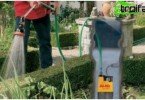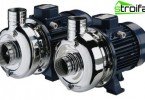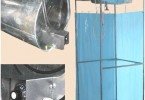How to choose the right pump for the fountain and waterfall
Water constructions are a frequent element of the decor of summer cottages and suburban areas, because the murmur, the movement of water perfectly relieves stress and fatigue. But if only individual owners decide for the pool (for lack of space), then fountains and waterfalls can be seen often. They are different in height, design, form of jet release, water velocity. And all these parameters are largely provided by the pump for the fountain, so to speak, its “heart”. And for the motor to work without overloads, it must be correctly selected. We will understand what technical characteristics it is important to consider when choosing a fountain pump..
Content
- Surface type pump: advantages and features of application
- Submersible systems: how to choose for a fountain and a waterfall
- We select power for the fountain
- Waterfall pump
- Where are submersible pumps placed??
Specialists in the installation of fountain equipment divide all types of pumps into two categories:
- Dry, i.e. which, when installing the fountain, remain on the surface of the earth (in other words, surface);
- Wet – that work while at the bottom of the fountain bowl (submersible).
Each option has its advantages, but more often summer residents use submersible systems. When buying a pump for fountains, it is better to purchase it as a kit, immediately with nozzles. This saves time, and the elements will fit together in the inlets.
Surface type pump: advantages and features of application
If the owner of the site is engaged in the installation, then it will be easier to service the surface pump, because:
- it is not dismantled for the winter;
- You can hide it in the room when you leave the country house;
- power supply cables do not require mechanical protection;
- electrical safety protection system is much simpler and more understandable than submersible;
- when completely dismantled, do not require draining the fountain bowl.
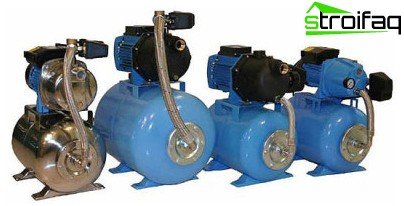
The surface pump standing at the edge of the fountain does not fit into the surrounding landscape, so decorate it with plants, or rather, hide it in a box
Such a unit significantly “growls” during operation, so it requires a soundproof box on top. And against the backdrop of a beautiful landscape it will have to be decorated somehow so as not to catch the eye.
Usually “dry” water pumps are used for large fountains or in the installation of multi-tiered waterfalls. At the same time, they try to install the unit closer to the water structure so as not to waste power, which is significantly reduced when passing through long pipes, hoses and nozzles.
If both a waterfall and a fountain are installed in the bowl, and the owner plans to supply them with one pump, then you should know in advance whether the selected pump model can give out different pressures at the same time. Indeed, for the operation of the fountain, an aggregate is needed that delivers a small volume of water under high pressure, and for waterfalls, on the contrary, a large volume of water under low pressure.
Submersible systems: how to choose for a fountain and a waterfall
The submersible pump is easier to install and invisible to others, but during operation, the owners will have to get it from the bottom of the bowl to service. Due to its higher efficiency, it is more economical than surface models. In addition, the proximity to the fountain nozzle avoids power losses and, again, saves energy. It is estimated that 30% less electricity is spent on servicing a fountain of one type than when using a “dry” unit.
We select power for the fountain
Submersible pumps for fountains and waterfalls are selected according to different parameters. So, for fountain installations, you need to calculate the height of the future jet, and, focusing on this figure, select the power of the unit. For example, for a structure with a jet height of 1.2 meters, you need a system that produces at least eight hundred liters per hour. For a fountain of one and a half meters, a submersible pump must pump at least 3 thousand liters. in hour. But keep in mind that you cannot select the maximum power for this height, otherwise the pump will work for wear. Orient, so that the height of the fountain is related to the pool bowl as 1: 3. In this case, the units operate with good efficiency..
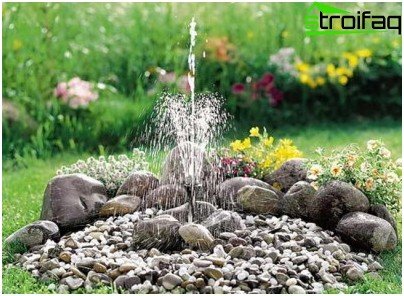
The maximum jet height is the main criterion for choosing the power and performance of pumps, but it is better to take a model with a stock of “strength” so that the mechanism does not work at the limit
Another point is stress. For small fountains, low-voltage mini pumps are available, operating from 12-24 V. So you will have to lay such a network.
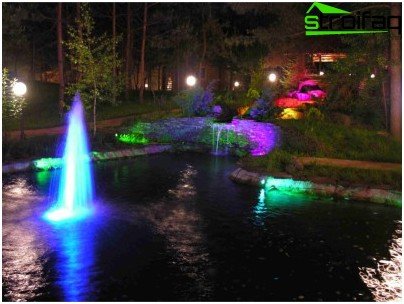
Low-voltage mini-pumps are often equipped with a jet height adjuster and additional spectacular elements, such as LED lights, so even a miniature fountain can be very effective
Correct hose sections are very important for pump efficiency. If the hose diameter is too small, the system will have high hydraulic losses. This means that there will be an excessive consumption of electricity. Therefore, choose a cross section of half an inch for weak motors, and at least an inch for high-performance ones.
When laying, try to avoid bends in the hose that also interfere with the normal operation of the system..
Waterfall pump
When creating waterfalls, you need to focus on the purity of the water in the bowl. If you purchase a system for the pool, then select according to the criteria that we considered above. But if a waterfall is created in a pond or an artificial lake, then it’s difficult to call clean water in them. And you will need not just a water pump, but specifically for pumping contaminated water. It is equipped with filters that filter sand and dirt, due to which the motor fails. If you intend to use an existing unit that is designed for clean water, then be sure to understaff it with a filter element.
Where are submersible pumps placed??
To install submersible units, a small pedestal is built at the bottom of the bowl. It can be brick, stone, etc. The main thing is to mount until you fill the bowl with water.

A household water hardness meter called a TDS meter will tell you when softeners should be added to keep pumping equipment healthy.
For any type of pump, the permissible level of water hardness is not more than 14 dH (German units). You can measure it with a small device – an electronic TDS meter.


